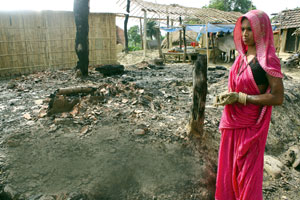 PICS: ANURAG ACHARYA |
SIRAHA -- While the media in Kathmandu can't get enough of behind-the-scenes intrigue about elections after the demise of the CA, here in dirt poor eastern Tarai, people don't have the luxury of discussing politics.
Aurhi in Siraha was ravaged by a devastating fire last month that rendered 600 families in two VDCs homeless. The prime minister visited the village while it was still smouldering and promised immediate relief and cash compensation for the victims. The media followed him around, and tv channels reported the visit live.
"I had never seen so many cars in our village, some with dish antennas on their roofs," recalled excited tenth grader, Prabhu Yadav. But when I visited the village this week, there were no outsiders except a few relief workers distributing construction materials, mosquito nets and plastic buckets to the families.
Scrabbling in the ashes was a family cooking half burnt grains of wheat salvaged from their charred home. Mehrun Khatun is living in the open with her five children, she asked me to relay this message to Kathmandu: "Can you tell the prime minister we need the money he promised now so that we can survive and rebuild our homes. When the rain comes there will be disease, and the children will be sick."
In nearby Shivanagar VDC, 137 homes were destroyed in another fire two weeks before Aurhi. That fire didn't get much media attention because the devastation wasn't big enough, and because neither the prime minister nor any high-profile public figure visited afterwards. Peasant families sold oxen and borrowed money to rebuild their homes, but none of that made it to the news.The national media gave us a blow-by-blow account of the month-long protest in the Far West last month, and the smallest of political demonstrations in Kathmandu are classified as 'Breaking News', but it has no time for the personal tragedy of the poorest villages of Nepal's poorest districts.
"The prime minister's helicopter flew right over us and Miss Nepal probably does not even know the name of our village," Bishnu Dev Yadav, whose 12-member family is homeless and destitute after the fire, told me.Media is centred on the centre. This is true not just in Nepal, but all over the world. The periphery doesn't sell, so the periphery isn't covered. Nepali journalists have struggled for press freedom, and for people's right to know, but who really decides what is news, who should get priority in coverage, and what influences these decisions?
The reason Aurhi and Shivanagar did not grab headlines for long could be that there was only one death. The media has moved on and will probably ignore the disease and deaths that will stalk survivors for years.
A fire in Siraha, or an epidemic in Dailekh, do not make it to 'Breaking News'. To make it to the headlines, the event has to be in or close to the capital, relatively well-off people should be affected, the number of victims should cross a certain threshold. And the prime minister or Miss Nepal should pay a visit, that will always get you a headline.
Read also:
Up in flames
Stateless in new Nepal, GEORGE VARUGHESE and PEMA ABRAHAMS
Inclusion without citizenship is impossible



